Little Green Light is a cloud-based donor management system for fundraisers.
Subscribe to get our latest product updates, best practices and tips to grow your nonprofit.
In this guest post, Adam Weinger, President of Double the Donation, provides a comprehensive overview of matching gifts and how your nonprofit organization can reap the rewards of a matching gift program.
Your donors are what keep your organization running. Without their support, your nonprofit would struggle to complete projects, help your communities, and accomplish your mission. But what if you could receive twice as many donations without pouring money into donor acquisition? It’s not as crazy as it sounds.
With the help of corporate matching gifts, your nonprofit can start doubling the donations of your existing supporters. Of course, there are limitations, deadlines, and best practices that your nonprofit should be aware of before you start marketing matching gifts to your donors.
That’s what this overview is for. Let’s dive in and learn about matching gifts.
Here are the questions we’ll be answering:
1. What are matching gifts?
2. How do you know if your nonprofit is matching-gift eligible?
3. How much will companies match?
4. What are the deadlines for matching gifts?
5. When should nonprofits promote matching gifts?
6. How can nonprofits promote matching gifts to their donors?
What are matching gifts?
At the most basic level, matching gifts are contributions that a company will make after an employee has donated to a nonprofit. Of course, they can be much more complicated than that, but we’ll go into the nitty gritty details in further sections.
For now, it’s easiest to think about matching gifts as the “Buy One, Get One Free” sale of the fundraising world:
1. Your nonprofit solicits a contribution from a supporter.
2. That donor gives $50.
3. The donor submits a matching gift request to their employer.
4. The employer reviews the request to see if the donation and the nonprofit meet the requirements.
5. If all standards are met, the company will match the donation at the predetermined ratio (often 1:1, but sometimes as high as 4:1).
See how matching gifts are like a BOGO sale? You basically get two donations for the acquisition price of one!
How do you know if your nonprofit is matching-gift eligible?
Matching-gift eligibility isn’t a one-size-fits-all standard. Companies set their own rules and requirements with regard to the types of nonprofits that they will donate to.
In general, though, most companies will match donations to:
* Environmental organizations
* Arts and cultural institutions
* Educational nonprofits
* Family and community organizations
* Health and human services nonprofits
Few businesses will match donations to political campaigns or religious organizations.
How much will companies match?
The ratios and amounts that companies will match differ greatly. Some businesses will put up fifty cents for every dollar, while others will match employee donations at a 4:1 ratio! Additionally, the minimums and maximums that companies institute can vary.
Some corporations will match $1 donations, while others require a threshold to be met. Maximums also differ, with some companies matching up to $5,000 and others doubling donations upwards of $20,000.
For example, Johnson & Johnson has a generous matching gift program that matches gifts between $25 and $10,000 at a 2:1 ratio for employees and a 1:1 ratio for retirees. Additionally, General Electric (the first company to match employee donations) will match donations ranging from $25 to $50,000 at a 1:1 ratio to most U.S.- and U.K-based nonprofits. GE doubles donations made by employees and retirees as well as spouses of employees and retirees.
With a little research on your part, you can uncover the match ratios and amounts of the top companies that donate to nonprofits.
What are the deadlines for matching gifts?
Matching gift deadlines are always set by the company doing the matching. Generally speaking, the deadlines range from several months to a year. Some companies will accept matching gift requests a couple months into the following calendar year of the initial donation, while others require the paperwork three months to the date after the donation was made.
The most common deadlines you’ll come across are:
* The end of the calendar year. As soon as January 1 rolls around, a donor loses the ability to submit a request for a matching gift.
* A certain number of months after the donation date. Donations can be matched anywhere between a few months and a year, depending on the company.
* End of January or February in the year after the donation was made. Instead of having a deadline at the end of the calendar year, some companies will extend it for an extra month for employees to get their submissions in.
Whatever the case, know that matching gift deadlines vary, and that it’s never too late to promote matching gifts to all of your donors. Not only will it give your organization another way to get in touch with your supporters, but you’ll also be able to build stronger relationships with them in the process.
When should nonprofits promote matching gifts?
Because of the aforementioned deadlines, it’s imperative that your donors know about matching gifts sooner rather than later. Your promotions should fall into three main categories:
1. Immediately after a donation is made.
2. At the end of the calendar year.
3. During the holiday season.
Let’s look at each one separately.
Immediately after a donation is made
You should already be sending out emailed acknowledgements after your donors make contributions online or otherwise. Those same acknowledgements can be used to promote matching gifts! Think about it: a donor has just finished the donation process. They check their inbox and see an email prompting them to look into matching gifts. Their contribution is fresh in their mind; they’re more likely than ever to submit a matching gift request to their employer.
Let’s look at an example:

This acknowledgement email from the Institute of Electrical and Electronics Engineers (IEEE) properly thanks the donor for his contribution. It also includes a link and a graphic that grabs the recipient’s interest and leads him to more information.
Promote matching gifts to your donors immediately after they make a donation to increase the chances that they’ll look into having it doubled.
At the end of the calendar year
As we mentioned before, many matching gift programs have deadlines that are near the end of the calendar year. Therefore, it makes sense for your nonprofit to promote matching gifts before January 1.
Send out reminders to your donors via:
* Email
* Direct mail
* Social media
* And more!
This way, they’ll be up to date and informed about matching gifts before the deadline creeps up on them.
During the holiday season
Admittedly, the holiday season is during the end of year, but there’s a different reason you should promote matching gifts to donors at this time. As we stated above, promoting matching gifts during the end of the calendar year encourages them to pursue matching gifts before the deadlines. But the end of the year also puts donors in a more charitable mood. Part of this is due to the general sense of goodwill that everyone has. But it’s also due to the fact that donors have a better grasp on their financial situations at the end of the year.
Let’s look at an example of a holiday season matching gift promotion:

This university’s email serves as a donation appeal and a matching gift promotion. They even have a festive background that mirrors the holiday season.
Bottom line: Make sure that your matching gift promotions go out at the right times!
How can nonprofits promote matching gifts to their donors?
Glad you asked! Even though matching gifts are a win-win-win situation for donors, employers, and nonprofits, few employees know that such programs exist, leaving money on the table when it comes to asking for donations. Your nonprofit can’t afford to leave behind that kind of money. The answer is to promote matching gifts to all of your donors. There are two reasons for this:
There’s really nothing to lose by marketing matching gifts to your supporters. Let’s look at a few ways you can inform donors about doubling their donations.
Promote matching gifts during the donation process
Donor engagement is at its peak during the donation process. Individuals are excited about giving to your organization and are actively supporting your cause with their donation. It’s therefore the perfect time to encourage them to look into doubling their donations. Let’s take a look at some examples.
On an online donation page

In this instance, Texas A&M’s Association of Former Students has placed a matching gift tool within their donation form.
While donors are filling out the rest of the fields, they can also easily find out if their employer will match their donation. They also tell donors, “The lookup includes instructions for submitting matching gift paperwork,” so that supporters know how to double their donations as soon as possible. If the employer has a matching gift program, the donor can fill out the match ratio for their donation. It’s that simple.
Marketing matching gifts on your donation page is crucial for receiving twice as many donations sooner rather than later.
On an acknowledgement page
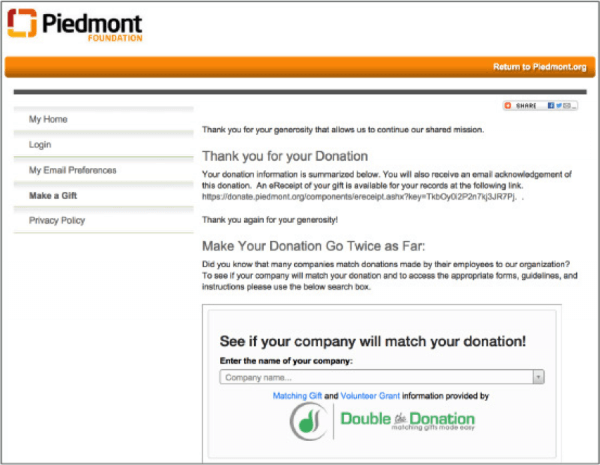
Additionally, your organization can promote matching gifts immediately after donors have completed an online donation. The Piedmont Foundation uses their acknowledgement screen as another opportunity to spread the matching-gift news. Notice that they properly thank the donor first. Proper acknowledgement is crucial for boosting donor retention, and you don’t want to risk driving a supporter away due to a lack of gratitude. After a genuine acknowledgement, the Piedmont Foundation dives into the matching gift information. They even include a tool that allows donors to check if their employer will double their donation.
The end result?
* Donors have their donations matched by their employers sooner rather than later.
* Your organization receives twice as many gifts.
* The employer is perceived as more charitable in the long-run.
Everyone wins!
Promote matching gifts in your communications
You’re likely communicating with donors in a few different ways. Maybe you send out a monthly emailed newsletter. Perhaps your donors regularly interact with you on social media. Or you might be using more traditional methods, like direct mail.
Whatever the case is, you can promote matching gifts within your existing communications.
Let’s discuss each one separately.
Email newsletters
Email is a quick and easy way to stay in touch with donors and keep them updated on projects, events, and other organizational info. They are also a great opportunity to talk about matching gifts. You can dedicate an entire newsletter to matching gifts by:
* Explaining the submission process in depth.
* Telling stories of how matching gifts have affected and helped your organization.
* Providing examples of companies that regularly match donations.
The Charcot-Marie-Tooth Association’s eNews email is dedicated to letting donors know about matching gifts. They also place highly visible links and buttons within the email that send donors to more information.
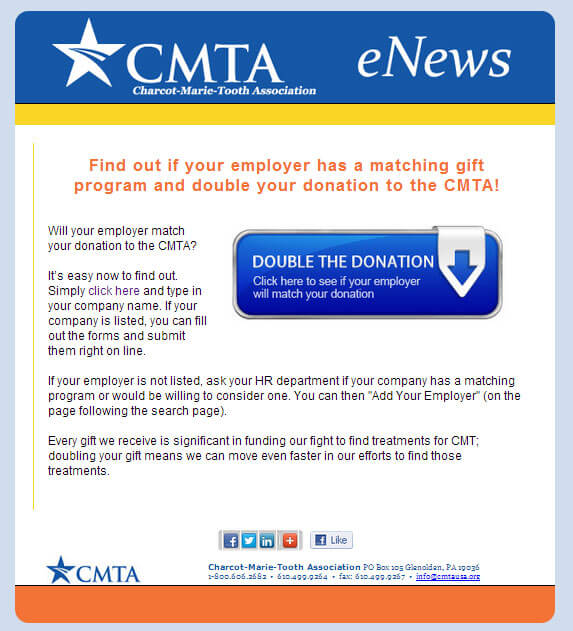
On the other hand, you can simply insert brief information about matching gifts in your existing newsletters.
Perhaps your capital campaign is moving into its public phase next month. Send out an email that:
1. Gets donors excited about contributing to the campaign.
2. Lets them know how their donations might be matched by their employers.
The National Kidney Foundation accomplishes this objective within their own emailed newsletter.
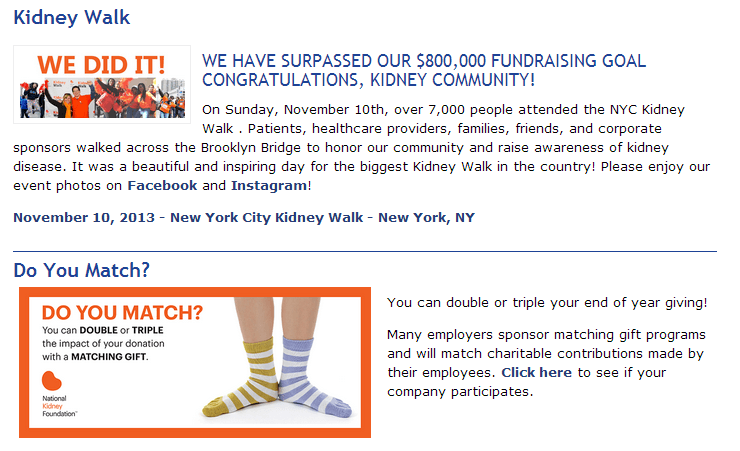
The top half of the email highlights a fundraising accomplishment, while the bottom half is dedicated to matching gift information. Recipients get the exciting news about a fundraising goal and are made more aware of matching gifts.
One email can accomplish both objectives!
Social media
Your donors are tweeting, posting, commenting, and liking as fast as their fingers can tap a smartphone screen. Why not use social media as a way to talk to them about matching gifts?
For Facebook posts, keep the message short and sweet, but make sure that you provide links to more comprehensive info. The ALS Association illustrates this point beautifully. They explain that donors’ gifts have the potential to be doubled and include a link to more info.
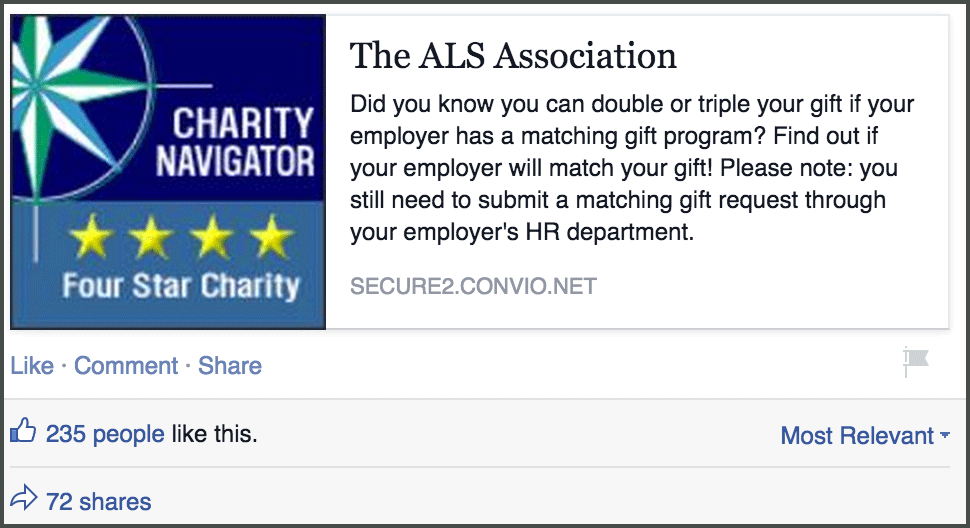
This single post received 235 likes and was shared 72 times!
Twitter
For Twitter, posts have to be even shorter; you only have 140 characters to work with, so make it snappy! The Center for Puppetry Arts shows us how a single tweet can be useful in providing quick matching gift info.
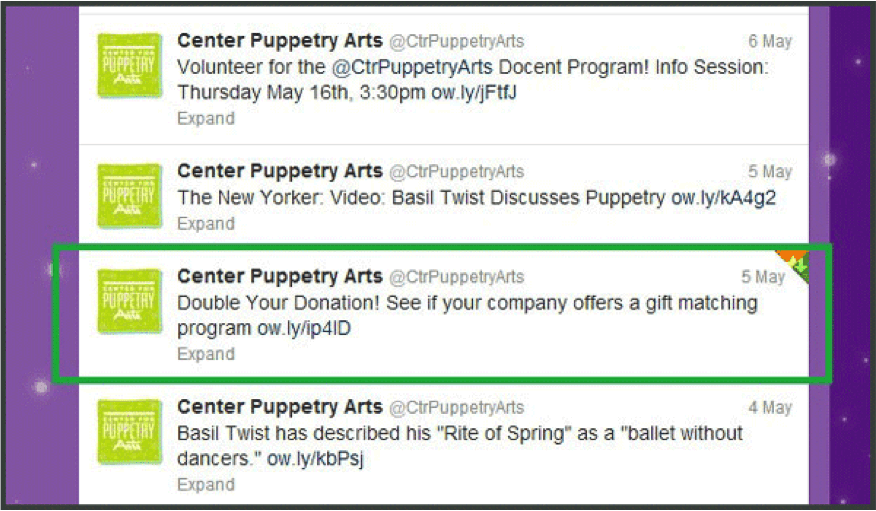
Even though the space is limited in a tweet, you should still provide users with a link to more information.
Promote matching gifts on your website
We’ve already covered promoting matching gifts during the donation process and in your communications, but your website is where new donors will likely go to find out more information about your nonprofit. Encourage those new supporters to double their donations by providing matching gift info on your website.
Let’s examine two ways.
Ways to give page
People who are looking for opportunities to donate and volunteer will inevitably end up on your Ways to Give page. This is the perfect opportunity to talk about matching gifts. The CASA of the Pikes Peak Region incorporates matching gifts under their more traditional ways to give (i.e., online, over the phone, by mail, etc.).
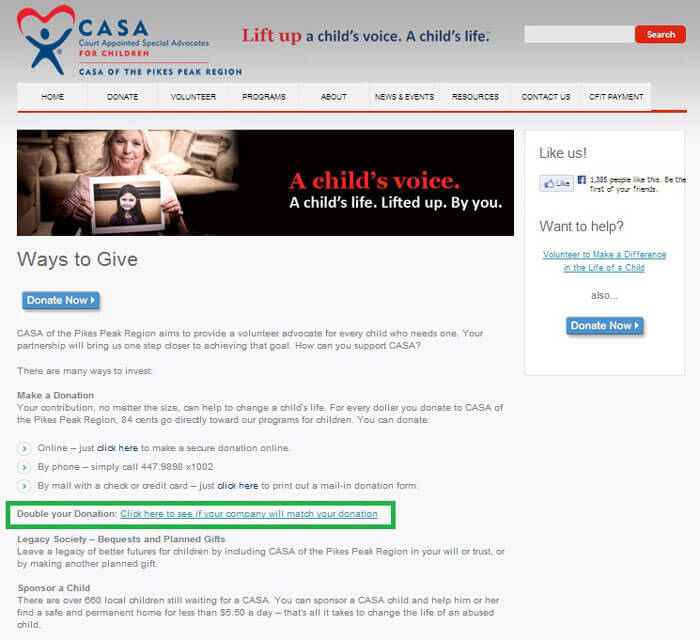
Note how CASA’s Ways to Give page also provides users with a link to more matching gift information. When you tell donors they can double their contributions, be sure you provide more context.
Dedicated matching gifts page
If you want to prominently feature matching gifts on your website, create a dedicated Matching Gifts page. Adrian College succinctly tells donors about the basic requirements for matching gifts and then highlights a tool that supporters can use to find out more specific information.
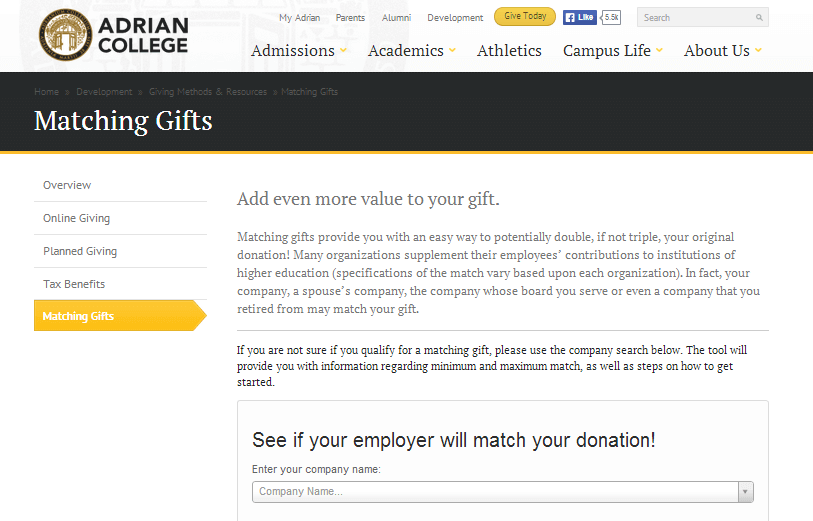
Notice that the Matching Gifts page falls under the main grouping of “Giving Methods and Resources,” making it easy to find.
Donors shouldn’t have to search too hard for matching gift info on your website. Make the process easy.
Matching gifts can be a prime opportunity for your nonprofit to receive twice as many donations. Hopefully this overview has given you some insight into the particulars of matching gifts and how you can properly promote them to your donors.
For more information, check out these useful resources:
Matching Gift Basics: https://doublethedonation.com/matching-grant-resources/matching-gift-information/
Top Matching Gift Companies: https://doublethedonation.com/matching-grant-resources/list-matching-gifts-companies/
Matching Gift Metrics:https://doublethedonation.com/matching-gift-metrics-nonprofits-should-track/
Types of Corporate Giving Programs:https://doublethedonation.com/10-types-of-corporate-giving-programs/
 Adam Weinger is the President of Double the Donation, the leading provider of tools to nonprofits to help them raise more money from corporate matching gift and volunteer grant programs. Connect with Adam via email or on LinkedIn.
Adam Weinger is the President of Double the Donation, the leading provider of tools to nonprofits to help them raise more money from corporate matching gift and volunteer grant programs. Connect with Adam via email or on LinkedIn.
Ready to try LGL? Get your first 30 days free. No credit card required.